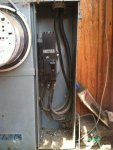jaggedben
Senior Member
- Location
- Northern California
- Occupation
- Solar and Energy Storage Installer
I'm considering in-line fuses as an overcurrent device to protect feeders downstream from a tap to a solar source. This follows 705.12(D)(2)(1) in the 2014 code. Basically it could allow me to deal with the situation where a customer has a service panel that consists only of a single breaker feeding a sub well inside the house. I'd tap the feeder to a disconnect for the solar, and put the in-line fuses to protect against the potential issue of the utility+solar overloading the feeder. (Not a real problem, but that's another discussion....) It would be a lot easier than installing a new subpanel and bringing the feeder back and forth.
The only thing is... I've never actually seen in-line fuses like this and I'm not sure what product exists that would actually be suitable. The most likely fuse ratings I'd need would be 100, 125, and 200. Googling 'in-line fuses' gets me all automotive results not suitable.
Anybody have any product suggestion, or can confirm that such things would work for what I'm talking about?
Other thoughts? Pitfalls?
The only thing is... I've never actually seen in-line fuses like this and I'm not sure what product exists that would actually be suitable. The most likely fuse ratings I'd need would be 100, 125, and 200. Googling 'in-line fuses' gets me all automotive results not suitable.
Anybody have any product suggestion, or can confirm that such things would work for what I'm talking about?
Other thoughts? Pitfalls?


